🦠 Bee Pests
Insect Pests & Diseases of Honey Bee
Which of the following statement is not correct realted to pests of honeybees?
Insect Pests
1. Greater Wax Moths

- Galleria mellonella (Galleridae, Lepidoptera)
- The greater wax moth is often reported to cause damage both to honey bee colonies and to bee products in tropical and sub-tropical Asia.
- Empty combs, rendered wax, comb foundation and bee collected pollen, if not properly stored and left unattended, almost always suffer considerable damage from wax-moth infestation.
- Silken galleries in the comb is due to the attack of Greater wax moth,
Galleria mellonella. They feed on wax, pollen propolis, royal jelly etc.
2. Lesser Wax Moth
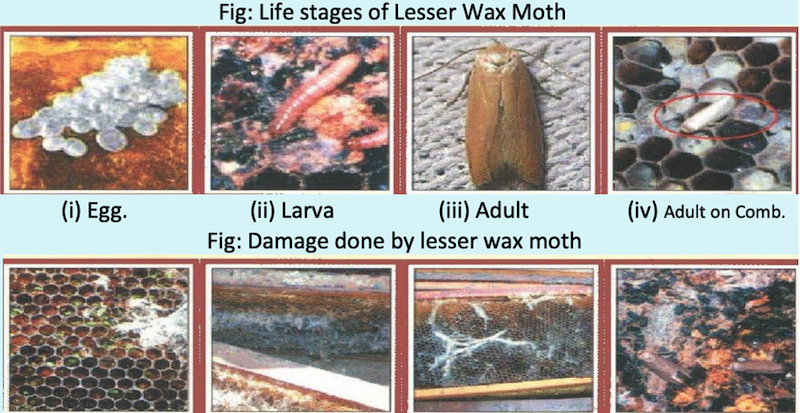
- Achroia grisella (Galleridae, Lepidoptera)
- The lesser wax moth is generally smaller than the greater wax moth.
- The lesser wax moth feed on the debris of the combs and at times de-cap the sealed cells exposing the pupae and this condition is called bald brood.
3. Ants

- All type of ants are among the most common predators of honey bees in tropical and subtropical areas.
- They are highly social insects and will attack the hives en masse, taking virtually everything in them: dead or alive adult bees, the brood and honey.
4. Wasps and Hornets

Different species of Wasps & Hornet (Vespa spp.)
- These insects are dangerous against the honey bees in all Asian countries including India.
- Among the most frequently reported are social wasps of the genus Vespa, which are widely distributed throughout the world.
5. Wax Beetle
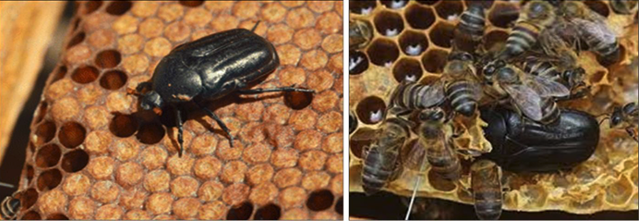
- Beetles infesting bee hive are Tenebroid beetle (Platybolium alvearium) & African small hive beetle (Aethina rumida).
6. Honey Bee Eater Birds
- Once airborne, the bees are virtually defenseless against birds, several species of which can tolerate their venomous stinging defense.
- The heavy traffic of bees flying in and out of the hives of commercial apiaries provides an exceptional opportunity for insectivorous birds, large numbers of which may be attracted by this situation.
- The level of damage caused by honey bee eater birds varies.
- Green Bee Eater Bird (Merops orientalis) and Black Drongo (Dicrurus macrocercus) are serious bird pests of honey bee.
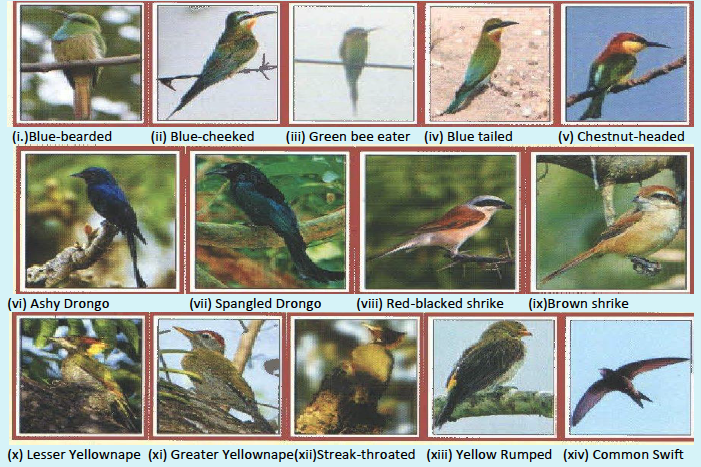
7. Bee Mites

- Parasitic mites are among the most serious enemies of honey bees with which beekeepers have to cope.
- Isle of Wright disease is caused by mite, Acarapsis woodi. They infect trachea.
- Varroasis is caused by mites Varroa jacobsoni and V. destructor. They infect broods.
- Following are most common mites affact on bees:
Mites Mode of living Host Habitat Varroa destructor Parasite A. mellifera Brood cell, adult bee Euvarroa sinhai Parasite A. florea Brood cell, adult bee Tropilaelaps spp. Parasite A.dorsata, A. mellifera Brood cell, adult bee Acarapis woodi Parasite A. mellifera, A. cerana Trachea of the adult bee Neocypholaelaps spp. Phoretic Apis spp. Adult bee, pollen-storage cell
Pest Management
- Phenols like propionic acid, benzaldehyde, acetic acid and propionic anhydride are bee repellents.
- Insecticides nontoxic to bees are Pyrethrum, Nicotine, Rotenone, Sulphur, 2,4-D.
Diseases
Nosema

- Nosema disease of honey bee is caused by
protozoa, Nosema apis. - It affects adult bees during cold/foggy and rainy weather.
- Nosema disease is generally regarded as
one of the most destructive diseases of adult bees, affecting workers, queens and drones alike. - This parasite produces spores that will contaminate the water and food sources within the hive. The worker bees unknowingly eat the spores when they eat or drink.
- Seriously affected worker bees are unable to fly and may crawl about at the hive entrance or stand trembling on top of the frames resulting into heavy mortality.
- The bees appear to age physiologically, their life-span is much shortened and their hypopharyngeal glands deteriorate, the result is a rapid dwindling of colony strength.
- Nosema directly affects a honey bee’s digestive system. Colony’s suffering from the Nosema apis parasite may display signs of dysentery. This can be seen in runny yellow or golden drop marks that can measure ¼” to 2” in length.
American Foul Brood

- American foul brood is a
bacterial diseasecaused by Paenibacillus larvae and is transmitted through spores. - The first signs of American foulbrood are sunken and damaged cappings on the sealed brood.
- Larvae die in unsealed cells.
- The dead larvae turn yellow at first and then chocolate brown and are drawn down into the cells.
- On stirring with a probe such as a matchstick, the contents of the cell may rope out forming a characteristic fine elastic thread up to 3-5cm long.
- Sour odour is emitted.
European Foul Brood

Bacterial disease- European foul brood is a
bacterial disease, Melissococcus plutonitts and is transmitted through spores. - An uneven or patchy brood pattern.
- Dead and discoloured larvae in uncapped cells. In some circumstances larvae may die after capping.
- Infection with EFB may sometimes have a strong ammonia-like (sometimes described as sour) smell.
- Dead larvae change colour from a healthy pearly white to yellow and then to a brown colour and become a liquefied mass.
- On stirring with a probe such as a matchstick, the contents of the cell may rope out forming a characteristic fine elastic thread up to 1.5 cm long.
Chalky Brood Disease

- Chalk brood is a
fungal diseasecaused by Ascosphacra apis. - The fungus rarely kills infected colonies but can weaken it and lead to reduced honey yields and susceptibility to other bee pests and diseases.
- White and mouldy hard larvae white or grey/black mummies in cells on the floor, or out the front of the hive
Stone Brood Disease
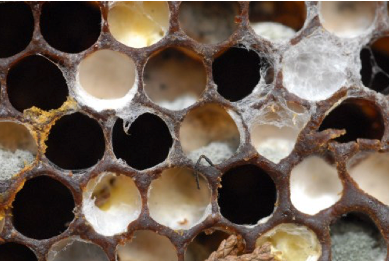
- Stonebrood is a fungal disease that affects adult honeybees and the brood (larvae and pupae).
- The main species of fungi responsible for the disease in honeybees are Aspergillus flavus and, less frequently, Aspergillus fumigatus and Aspergillus niger.
- The disease is transmitted via food or through direct contact.
- Green mummified larvae can be observed in the brood combs, and on the bottom board or the landing board of the hive. The mummified larvae resemble little white, yellow or green stones and are hard to crush, unlike larvae affected by chalkbrood (which are sponge-like).
Sac Brood Disease
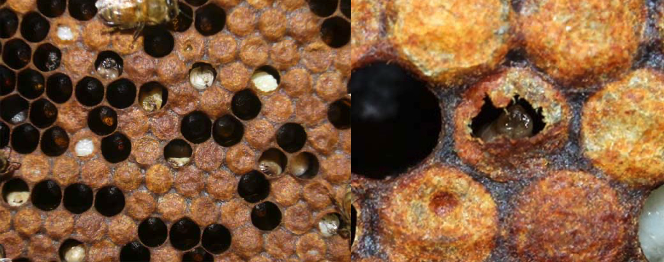
- Sac brood is a
virual diseaseattacking Apis mellifera brood. - The diseased larvae appear sac like and hence the name.
- Sac-brood disease is perhaps the most common viral disease of honey bees.
- An uneven brood pattern with discoloured, sunken or perforated cappings scattered through the brood cells. This is generally caused from adult bees trying to remove infected brood.
- Infected larvae die shortly after capping and fail to pupate.
- The larva dies with its head characteristically raised toward the top of the cell and stretched out on its back in the cell (i.e. banana shape).
- Larva is pearly white and look like sac filled with water.
References
- The book namely “Honey Bee Enemies and their Management” Written by M.S. Khan, Poonam Srivastava-AICRP on Honey Bees and Pollinators CCSHAU-Hisa (HR)
- The book namely “Primary information of Beekeeping- Arya Gramoudhyog Sansthan -Kandara, Bagpat (U.P.)
- Abstract of research publication- R.K. Thakur,H D Kaushik and Sunita Yadav, AICRP on Honey Bees and Pollinators, CCSHAU-Hisar(HR)
- The Food & Agriculture Organization’s web site-www.fao.org/icatalog /search /dett.asp?aries_id=107959
- The List of diseases of the honey bee - Wikipedia, the free encyclopedia, web siteen.wikipedia.org/wiki/List_of_diseases_of_the_honey_bee.
- Honey Bee Parasites, Pests, Predators and Diseases - View, Websitehttps://agdev.anr.udel.edu/.../honey-bee.../honey-bee-parasitespests-pred.
- Honey Bee Pests & Diseases - Beebase - Beekeeping information, Website- secure.fera.defra.gov.uk › Public Pages › Bee Pests, Diseases & Maps...
- [PDF]Honey bee diseases and pests: a practical guide - FAO.org, Websiteftp: //ftp.fao.org/docrep/fao/012/a0849e/a0849e00.pdf
- Honey Bee Pests and Diseases Ontario Beekeepers' Association, WebsiteWww. ontariobee.com/outreach/honey-bee-pests-and-diseases.
- Diseases and Pests of Honey Bees – Bee source Beekeeping, Websitewww. beesource.com › Resources › USDA 11. Self reliance by beekeeping, Natural Resources Development Multi State Cooperative Society Limited(NARCO), Sec.12, Noida (U.P.)
- https://www.projectapism.org/project-apis-m-blog/honey-bee-health-coalition-releases-information-to-help-beekeepers-veterinarians-manage-foulbrood
Which of the following statement is not correct realted to pests of honeybees?
Insect Pests
1. Greater Wax Moths

- Galleria mellonella (Galleridae, Lepidoptera)
- The greater wax moth is often reported to cause damage both to honey bee colonies and to bee products in tropical and sub-tropical Asia.
- Empty combs, rendered wax, comb foundation and bee collected pollen, if not properly stored and left unattended, almost always suffer considerable damage from wax-moth infestation.
- Silken galleries in the comb is due to the attack of Greater wax moth,
Galleria mellonella. They feed on wax, pollen propolis, royal jelly etc.
2. Lesser Wax Moth

- Achroia grisella (Galleridae, Lepidoptera)
- The lesser wax moth is generally smaller than the greater wax moth.
- The lesser wax moth feed on the …
Become Successful With AgriDots
Learn the essential skills for getting a seat in the Exam with
🦄 You are a pro member!
Only use this page if purchasing a gift or enterprise account
Plan
Rs
- Unlimited access to PRO courses
- Quizzes with hand-picked meme prizes
- Invite to private Discord chat
- Free Sticker emailed
Lifetime
Rs
1,499
once
- All PRO-tier benefits
- Single payment, lifetime access
- 4,200 bonus xp points
- Next Level
T-shirt shipped worldwide

Yo! You just found a 20% discount using 👉 EASTEREGG

High-quality fitted cotton shirt produced by Next Level Apparel